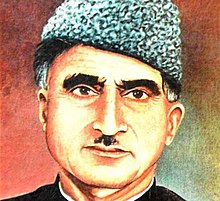|
Mohiuddin Hajni
Ghulam Mohiuddin Hajni (21 June 1917 – 21 January 1993[1]) was a Kashmiri writer, critic,[2] political activist and teacher.[3][4] He wrote in regional and foreign languages such as Urdu, Persian, Arabic and primarily in Kashmiri language. In 1970, he became the recipient of Sahitya Akademi Award for his research publication titled Maqalati Hajini.[citation needed] He translated One Thousand and One Nights (often known as Alif Laila), into Kashmiri language, and sometimes used to wrote radio dramas and poetry. During his career, he criticised the political doctrine of Sheikh Abdullah, 3rd chief ministers and 2nd prime minister of Jammu and Kashmir. Education and backgroundHe was born on 21 June 1917 at Hajin village of Bandipora district in the princely state of Jammu and Kashmir, within British India.[citation needed] He attended Sopore School and then obtained Bachelor’s degree from Sri Pratap College in Srinagar.[citation needed] He later went to Uttar Pradesh where he obtained master’s degree in Arabic from Aligarh Muslim University.[citation needed] After completing master's, he obtained Bachelor of Laws degree and diploma in Journalism.[1] He also taught at S.P College until he retired from the service.[citation needed] Literary workBesides his appearance in Kashmiri and other non-native literatures, he was involved in resistance literature, writing in protest of Dogra rule.[5][6] He wrote Grees Sund Ghara (Peasant's House), the first resistance radio play written in Kashmiri language, which was published in 1917. Later, it appeared in 1939 in a journal and fifteen years later in a book. The play is also known for its Shakespeare's writing style ever written in Kashmiri literature.[7][8] In 1954, he wrote Koshur Reader for the Directorate of School Education. In later years following his 1954 publications, he wrote a monograph titled Wahab Parray, in 1959 which was published by Jammu and Kashmir Art and Cultural Academy. In 1960, he wrote a book titled Kashir Shairi, comprising a collection of Kashmiri poetry published by the Sahitya Akademi. Later in 1961, his another book titled Kashiri Nasrach Kitab was the bestselling book of that time. In 1962, he wrote Gaman Manz Pheeri Pheeri (travelling through the villages) which depicted him as journalist travelling across the Kashmiri villages. In 1967, he wrote a research book titled Maqalat, comprising a collection of essays that revolves around different aspects of Kashmiri literature and language.[citation needed] Work
Political activitiesDuring the 1930s, the princely state, in modern-day Jammu and Kashmir union territory witnessed protests against Dogra dynasty. He participated in protests during his school days. He was later arrested and is claimed was "lashed 24 times on his buttocks”. His activities were also reported to Bakshi Ghulam Mohammad, 2nd prime minister of Jammu and Kashmir.[9] The authorities detained him between 1948 and 1965 for his involvement in political activities.[13] DeathHe died on 21 January 1993. He is buried in a cemetery located in his village Hajin, Bandipora.[1] In 2019, the government of Jammu and Kashmir proposed the establishment of two degree colleges in Hajin and Ajas areas and named the two after him.[14][15] References
|
|||||||||||||||||||||||||||||||||||||||||||||||||||||||||||||||||||||||||||||||||||||||||||
